Are you worried about the safety of your patio door? Have you had a break-in before or feel too vulnerable to keep it unlocked? Whatever the reason, protecting yourself and your property with adequate security is essential.
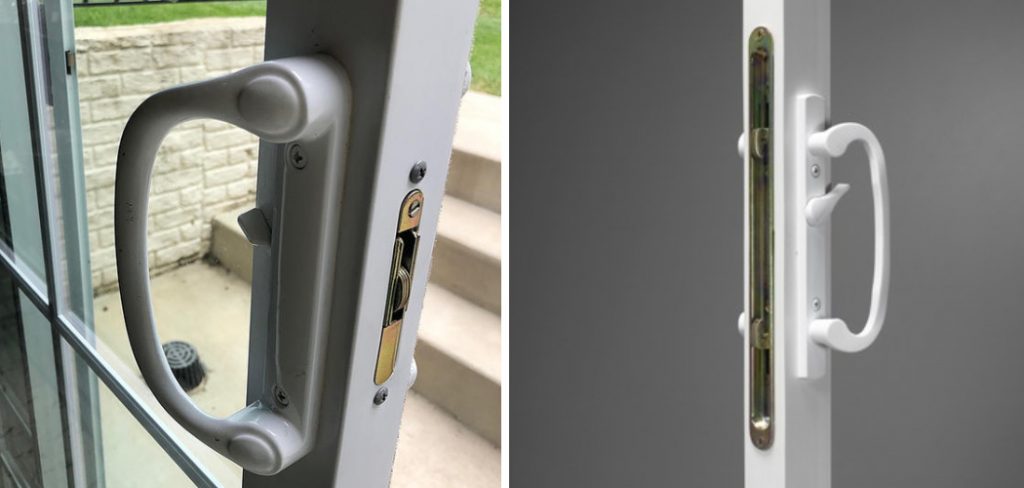
Patio doors are often the preferred entry point for burglars, as they are frequently left unlocked or can be easily forced open. In this guide, we will show you how to lock patio door and provide additional tips on securing it further.
Nowadays, there are lots of options out there when it comes to enhanced home security. One solution is locking up your patio door for added peace of mind. This blog post will provide an in-depth guide on properly locking and securing your patio door so that no one can enter unannounced!
What Will You Need?
Before we get started, here’s a list of some essential tools and items you will need to lock your patio door successfully:
- A sturdy deadbolt lock
- A locking mechanism with a key or keypad
- Screws and screwdriver
- Some security film or glass break detectors (optional)
Now that you have everything you need let’s get started with a step-by-step guide on how to lock your patio door.
10 Easy Steps on How to Lock Patio Door
Step 1. Identify the Locking Points:
Start by identifying your patio door’s locking points. These are typically located on the side of the door frame and can usually be found by looking for a small hole or slot on the door’s edge. Some doors may have multiple locking points, while others may only have one.
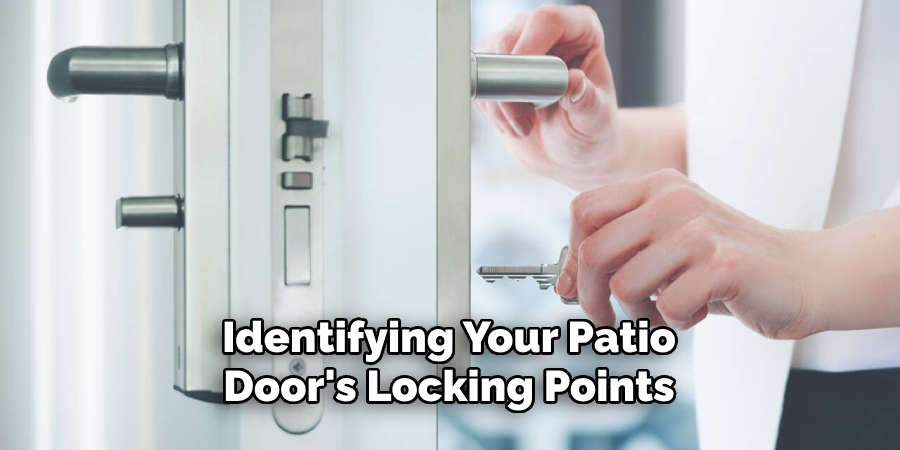
Step 2. Install the Deadbolt Lock:
The next step involves installing the deadbolt lock at your identified locking points. First, position the lock cylinder carefully on the door frame. Use screws and a screwdriver to fix the cylinder securely to the door. The deadbolt lock is a fundamental component of your patio door’s security, so make sure it is installed correctly and firmly.
Step 3. Incorporate a Key or Keypad Locking Mechanism:
After securing the deadbolt lock, you must install the key or keypad locking mechanism. This mechanism allows you to lock and unlock your patio door from the outside. Ensure it’s installed at a convenient height and where it can be easily accessed.
Use your screws and screwdriver to affix the mechanism securely to the door. Now, your patio door has a dual security system; the deadbolt lock provides internal security, while the key or keypad lock offers external security.
Step 4. Test the Locking System:
Once both the deadbolt and the key or keypad locking mechanism are installed, it’s time to test your new locking system. Ensure that the key or keypad successfully locks and unlocks the deadbolt.
It’s essential to verify that the locks are working as expected to ensure the effectiveness of your new security measures. Perform multiple tests to confirm the reliability of your patio door’s locking system.
Step 5. Apply Security Film:
This step is optional but highly recommended for enhanced security. Apply a security film to your patio door glass. This film makes the glass more challenging to break, drastically increasing the time and effort required for a break-in – which can deter burglars. Ensure the film is applied evenly without bubbles or creases to ensure maximum effectiveness.
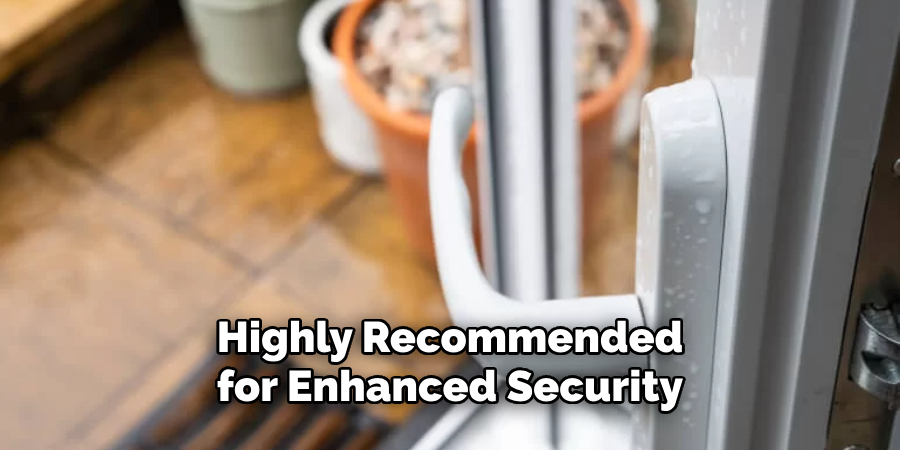
Step 6. Install Glass Break Detectors:
As an additional security measure, consider installing glass break detectors. These devices can sense the specific frequency of breaking glass and trigger an alarm or alert, providing an extra layer of protection against break-ins.
Install the detectors following the manufacturer’s instructions and ensure they are positioned to effectively cover the entire surface area of the patio door glass. After installation, test them to confirm they’re functioning as expected.
Step 7. Regularly Maintain Your Locks:
Maintenance is vital to ensuring long-lasting and adequate security. Regularly check your locks for signs of wear and tear. If needed, lubricate the lock mechanisms to ensure they function smoothly.
If you spot any signs of damage or malfunction, address them immediately to secure your patio door. Regular maintenance will prolong the life of your locks and keep them in good working order.
Step 8. Enhance Visibility:
A well-lit patio can be a significant deterrent for would-be intruders, increasing their chances of being seen. Consider installing motion sensor lights that activate when movement is detected. Position the lights to illuminate your patio and the surrounding area fully. Remember to check the bulbs regularly and replace them to ensure continuous and adequate lighting.
Step 9. Install Security Cameras:
For an additional layer of security, consider installing security cameras. These provide a visual deterrent and also record evidence if a break-in occurs. Cameras should be installed strategically to capture the entire patio area, with a particular focus on the patio door.
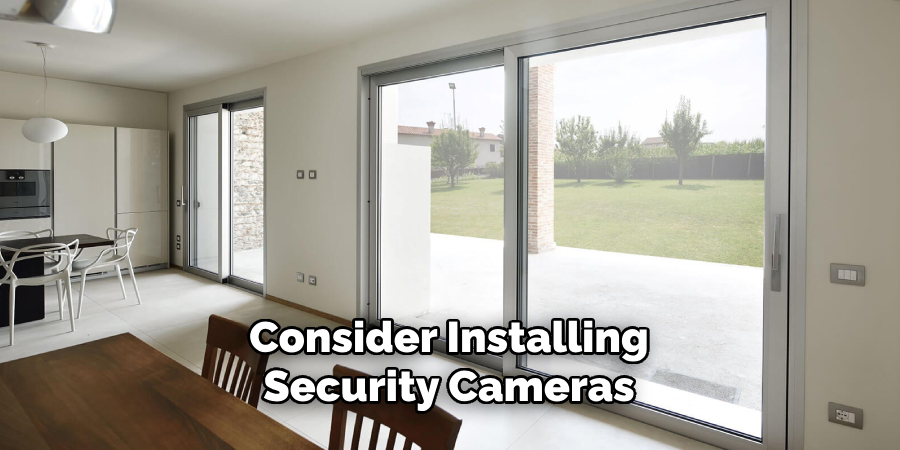
Most modern security cameras come with features like night vision, motion detection, and remote access via mobile devices, providing comprehensive security for your home.
Step 10. Regular Review of Security Measures:
Finally, regularly review your patio door security measures to ensure they are up-to-date and functional. Security technology continually evolves, so staying informed about new developments can help enhance your home’s safety. Also, regular checks will help identify potential vulnerability areas, allowing you to address them promptly and maintain a secure environment for your home.
By following these ten easy steps, you can effectively lock and secure your patio door, providing peace of mind knowing that your home is protected.
5 Additional Tips and Tricks
- Always Double Check: The first and simplest tip is to ensure your patio door is securely locked before leaving the house or heading to bed. It’s easy to forget, but it’s an essential step in home security.
- Use a Bar or Rod: Consider placing a steel bar or rod in the track of your sliding patio door. This adds an extra level of security and makes it more difficult for intruders to force the door open.
- Install a Patio Door Alarm: Alarms are an effective deterrent. If your patio door is tampered with, the noise can scare off potential intruders and alert you to the situation.
- Consider Upgrading Your Lock: If your door has an older or flimsy lock, it might be worth investing in a more robust, more modern lock. There are many secure options available that are designed specifically for patio doors.
- Keep Control: Finally, keep track of who has keys to your patio door. If you’ve recently moved into a new home or have had work done on your property, it’s a good idea to rekey or change the locks.
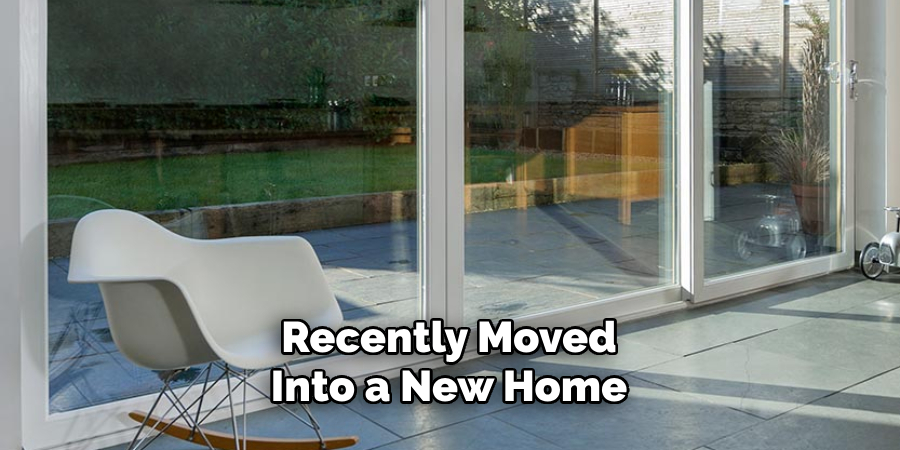
With these additional tips and tricks, you can ensure that your patio door is always locked and secure.
5 Things You Should Avoid
- Avoid Leaving The Door Unattended: Never leave your patio door unlocked and unattended, even if you are just in the other room. Intruders can take advantage of these short periods of vulnerability.
- Avoid Displaying Valuables: Don’t leave valuable items, like electronics or jewelry, in clear view from your patio door. This can make your home a more attractive target for burglars.
- Avoid Neglecting Regular Maintenance: It’s crucial to check the condition of your patio door’s lock regularly. If it’s worn out or rusty, it’s time to replace it to ensure optimal security.
- Avoid Relying Solely on the Factory Lock: The lock with your patio door may need to be more secure. Consider adding a lock or using a security bar for extra protection.
- Avoid Ignoring Your Landscape: The area around your patio door can deter or invite intruders. Avoid placing tall shrubs or trees near the patio door, as they can provide a hiding spot for burglars. Adequately lit and well-maintained landscapes can deter potential intruders.
By avoiding these things, you’ll be one step closer to maintaining a more secure home.
Why is It Hard to Open a Patio Door?
There are a few reasons why your patio door might be difficult to open. The most common reason is that the rollers, which allow the door to slide open and close, may need cleaning or replacement. Additionally, debris or dirt buildup in the track can cause difficulty when opening or closing the door.
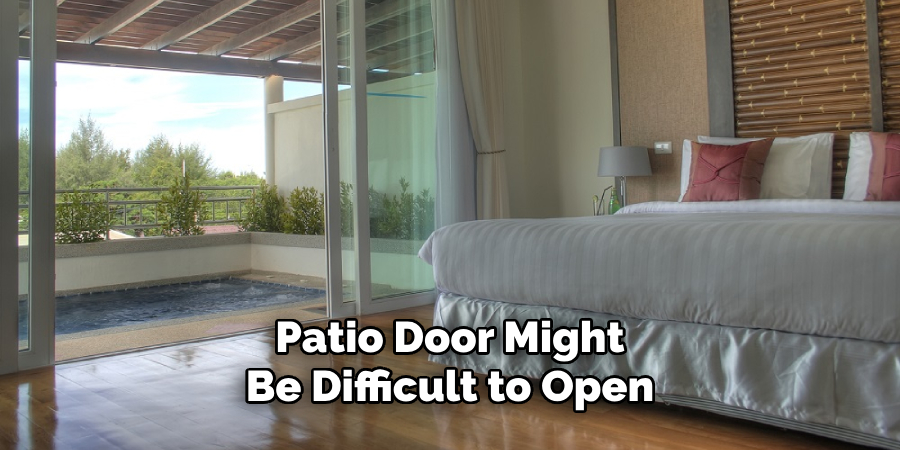
Another possible reason could be an issue with the alignment of the tracks, causing them to rub against each other and make it challenging to move the door smoothly.
Moreover, if your patio door has an older or faulty lock, it can also make it difficult to open and close it. It’s essential to regularly maintain and clean your patio door to prevent these issues from occurring. If you continue to have problems with opening or closing your patio door, it’s best to consult a professional for assistance.
How Do Sliding Patio Doors Work?
Sliding patio doors have a simple design that allows them to open horizontally along a track. The door’s outer frame contains two panels, one stationary and one movable. The movable panel has rollers attached to the bottom, which glide smoothly on the track when opened or closed. This allows for effortless access to the patio.
Additionally, most sliding patio doors have a locking mechanism at the handle or in the frame, which secures the door when closed. The locking mechanism can vary depending on the door type, but they are usually simple. Some standard lock features include latch bolts, hook bolts, and deadbolts.
Overall, sliding patio doors are a convenient and popular choice for their functionality and modern design.
Conclusion
Ultimately, the best way to lock patio doors is to assess your security needs and decide which type of lock is best for your home. Many different models are available, so you can weigh your options and choose the best option. Taking appropriate security precautions gives you peace of mind and is an effective deterrent against burglary and other unwanted intruders.
Hopefully, the article on how to lock patio door has been informative and helpful. Remember to regularly check and maintain your patio door’s lock for optimal security, and follow the additional tips and tricks provided to ensure a secure home.
So don’t delay—invest in quality locks today to keep your patio door safe and secure. If ever in doubt, contact a local locksmith or patio door specialist who can advise you better on locking options and installation instructions.
About
Safety Fic is a distinguished figure in the world of Diy design, with a decade of expertise creating innovative and sustainable Diy solutions. His professional focus lies in merging traditional craftsmanship with modern manufacturing techniques, fostering designs that are both practical and environmentally conscious. As the author of diy, Safety Fic delves into the art and science of Safety Fic-making, inspiring artisans and industry professionals alike.
Education RMIT University
(Melbourne, Australia) Associate Degree in Design (Safety Fic) Focus on sustainable design, industry-driven projects, and practical craftsmanship. Gained hands-on experience with traditional and digital manufacturing tools, such as CAD and CNC software.
Nottingham Trent University
(United Kingdom) Bachelor’s in diyfastly.com and Product Design (Honors) Specialized in product design with a focus on blending creativity with production techniques. Participated in industry projects, working with companies like John Lewis and Vitsoe to gain real-world insights.
Publications and Impact
In diy, Safety Fic his insights on indoor design processes, materials, and strategies for efficient production. His writing bridges the gap between artisan knowledge and modern industry needs, making it a must-read for both budding designers and seasoned professionals.
